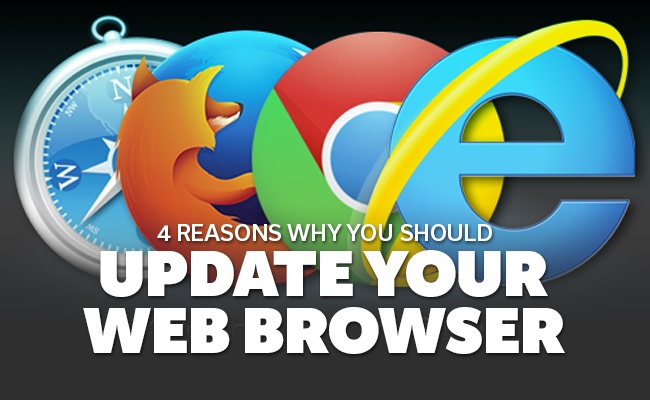
If you are running an older outdated web browser, you are not enjoying the browsing experience you should be. You are also opening yourself up to security vulnerabilities, which could compromise your computer. This is especially true in older versions of Internet Explorer. If you have Internet Explorer 9 or lower, you should upgrade. Here are 4 reasons to update your web browser:
New website technologies are often only supported by newer browsers. As businesses updated their websites utilizing these new web technologies, older browsers will not function properly and will not be able to display parts of the website.
 2. Security Risks:
2. Security Risks:A compromised web browser could make your personal information public. A compromised system could permit the download of key logging software, which could record and transmit any data that you type. More about keyloggers here. Vulnerable browsers may also facilitate the download of spyware that can capture passwords, credit card numbers and screenshots to pass along to hackers.
Every web page that loads in a browser triggers it to perform a number of different tasks. One of these tasks is loading component files. These files include images, programming scripts, and other resources that help improve the look and functionality of the website you’re visiting. Old browsers do not perform these tasks with the same speed as new browsers. This makes your experience on the Web considerably slower, and can sometimes cause your browser to crash or freeze.
Browser vulnerabilities affect both PC and Mac computers. In May of 2011, Firefox released a new version of its browser to resolve a security flaw, which could have allowed hackers to take control of computers running Windows Vista, Windows 7 and Mac OSX. Don’t let your browser be the weak link in your efforts to secure your computer.
SEE ALSO: Why Using A DIY Website Builder May Be A Bad Idea for Your Business
Getting an Internet browser is easy. Internet Explorer comes pre-installed with Windows, and Safari comes with Apple operating systems. Firefox and Chrome can be downloaded and installed by visiting their respective Web sites (using another browser).
Once you’ve got your browser of choice, keeping it updated is even easier. Internet Explorer (IE) updates are included as part of Windows system updates, so as long as you keep Windows updated, so is IE. Just run Windows Update from your start menu to see if any updates are available. You’|| see Internet Explorer updates listed under "Important Updates." If Windows is set to update automatically, then IE will be kept up to date as well.
Firefox notifies you when an update is available, and you can check for updates manually by hitting the "Check for Updates" button (find it by opening the Help menu and selecting "About Firefox"). Chrome actually updates itself whenever it’s running, and you can also check manually for updates under the "About Chrome" menu.
When an update for Safari is available, you’ll get an "App Updates Available" notification. This will take you to the app store where you can update all the software with available updates include Safari. You can also check for Safari updates by looking at the "Software Updates" list from the operating system’s Apple menu.
 Written By Mike Tungate
Written By Mike TungateHello! I am the Web Services Manager @ EnvisionIT Solutions. I create beautiful websites, branding and marketing systems for businesses. Let me know if you have any questions. I am an avid photographer and a lover of musical instruments.

Don’t trust your company’s critical data and operations to just anyone! This business advisory guide will arm you with 21 Revealing Questions you should ask any computer consultant before giving them access to your network.
7500 Jefferson St. NE
Albuquerque, NM 87109
505-823-3400